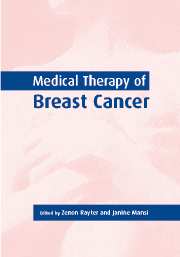Book contents
- Frontmatter
- Contents
- List of contributors
- 1 History of breast cancer therapy
- 2 Chemoprevention of breast cancer
- 3 Familial breast cancer
- 4 Hormone replacement therapy and breast cancer
- 5 Screening for breast cancer
- 6 The management of in situ breast cancer
- 7 Adjuvant systemic therapy
- 8 Adjuvant radiotherapy in the management of breast cancer
- 9 Predictors of response and resistance to medical therapy
- 10 Primary medical therapy in breast cancer
- 11 Medical therapy of advanced disease
- 12 Experimental approaches
- 13 The place of bisphosphonates in the management of breast cancer
- 14 Palliative care in breast cancer
- Index
7 - Adjuvant systemic therapy
Published online by Cambridge University Press: 06 January 2010
- Frontmatter
- Contents
- List of contributors
- 1 History of breast cancer therapy
- 2 Chemoprevention of breast cancer
- 3 Familial breast cancer
- 4 Hormone replacement therapy and breast cancer
- 5 Screening for breast cancer
- 6 The management of in situ breast cancer
- 7 Adjuvant systemic therapy
- 8 Adjuvant radiotherapy in the management of breast cancer
- 9 Predictors of response and resistance to medical therapy
- 10 Primary medical therapy in breast cancer
- 11 Medical therapy of advanced disease
- 12 Experimental approaches
- 13 The place of bisphosphonates in the management of breast cancer
- 14 Palliative care in breast cancer
- Index
Summary
The rationale for systemic adjuvant therapy
Up until approximately 25 years ago, it was considered that breast cancer metastases developed according to the anatomical and mechanistic principles first proposed by Halstead (1907). Metastases spread in a predictable fashion from the breast to the regional lymph nodes and subsequently to distant sites. Consequently, the aim of early breast cancer treatment was extensive surgery to remove local and regional disease. However, the Halstead principles were subsequently challenged by laboratory findings, biological hypotheses and clinical observations which have formed the rationale for systemic adjuvant chemotherapy. There is no orderly pattern of cancer cell dissemination, and the blood stream is of considerable importance as a route of dissemination (Fisher & Fisher, 1966), and so regional lymph nodes are of prognostic rather than anatomical significance. The high recurrence rate, especially during the first three years after a Halstead radical and extended radical mastectomy, suggest that micrometastases, which are not clinically detectable, are present at the time of surgery for the primary tumour and are unaffected by local treatment (Valagussa et al., 1978). Several studies have evaluated breast-conserving surgery alone or with radiotherapy (Fisher et al., 1991; Veronesi et al., 1993; Liljegren et al., 1994). A higher local recurrence rate among women who underwent lumpectomy did not adversely affect survival.
- Type
- Chapter
- Information
- Medical Therapy of Breast Cancer , pp. 153 - 177Publisher: Cambridge University PressPrint publication year: 2003



